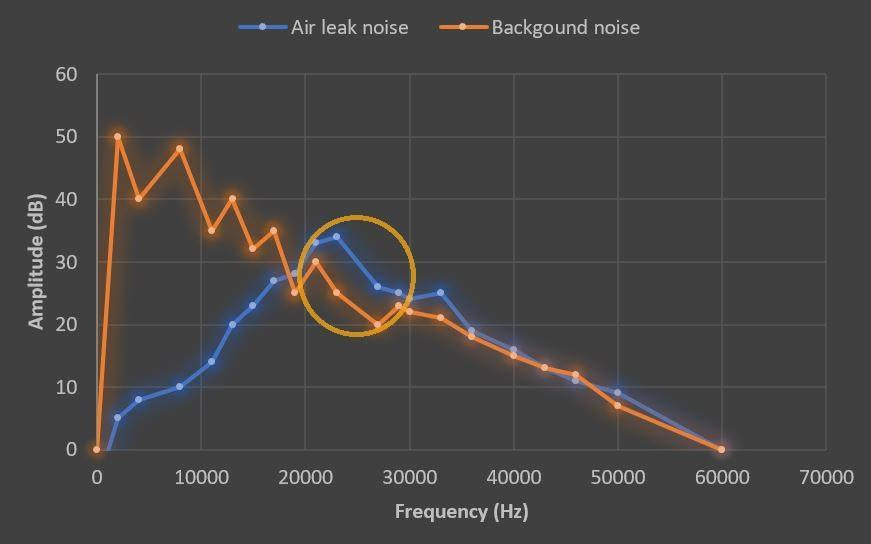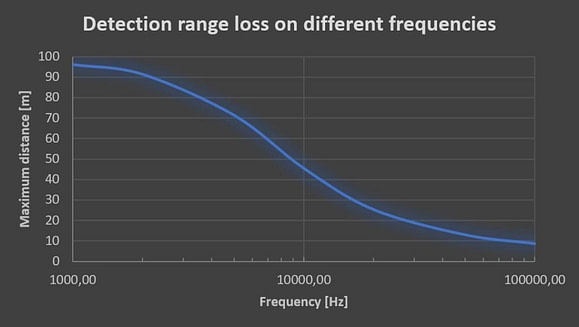Detecting air leaks or partial discharges efficiently with acoustic probes and acoustic cameras requires using the right frequencies. Staring only at the device’s frequency range can be misleading, as using frequencies too high or low can result in poor performance. In this article, we explain how to distinguish beneficial frequencies from those that might seem useful but necessarily are not.
Tackling background noise
When comparing standard ultrasonic detectors, you might get the impression that air leaks and partial discharges (PDs) emit only specific ultrasonic frequency sound (typically centered around 40 kHz), and in order to detect them, this frequency range should be used. However, this is not the truth—in some cases, it may be beneficial, but in others, it can harm the detection sensitivity.
The most suitable frequency used for detection depends on several different factors. Typical pressurized air leaks or PDs generate broadband sound that extends from audible to ultrasonic frequencies. It is important to note that the typical environment for locating these kinds of problems is not completely silent, but an industrial or outdoor environment with various levels of background noise.
Air leaks in factories
Factory halls are the perfect example of an environment full of background noise. By listening with your ears, hearing an air leak amidst all the noise is next to impossible. To overcome the cacophony of industrial sounds, acoustic probes and cameras generally use ultrasonic frequencies, since background noise interferes less at high frequencies. With air leaks, you can usually achieve good results when concentrating on sounds over 20 kHz.

Nonetheless, you often have interfering noise also at higher frequencies. In these cases, the device must be able to differentiate sound sources that resemble a leak from other interfering sound sources. Most acoustic probes and cameras in the market today enable the user to manually filter out any interfering noise, using sliders to select a frequency range that might work for the purpose. This type of time-consuming trial-and-error approach significantly increases the risk that many of the problems are left undetected.
Our approach is different: The NL Camera automatically detects sounds that resemble air leaks, giving better results with less effort required from the user. What is more, the camera removes nearly all of the interfering noise by default.
The detection distance matters with partial discharges
The distance to the source of the problem plays an important role in frequency selection. The higher the frequency, the quicker sounds attenuate over distance, causing the sensitivity and detection range to suffer. Here is an example: If you have a sound source that is measured 40 dB(Z) (typically a small leak or mid-sized PD) from a meter’s distance and a microphone is able to pick up sounds that are above 0 dB(Z), in normal conditions, you can detect the sound source from a distance of about 100 meters with 1 kHz and from about 10 meters with 100 kHz (read more about the detection range).

PDs usually occur outside. Due to high voltage safety precautions, it is not possible to get close to the source of the problem. With PDs, you benefit highly from using frequencies between 10 kHz to 30 kHz, such as getting better performance at a distance.

The performance on high frequencies linked to the number of microphones used
To detect very high frequency sound sources, the acoustic camera must have a multitude of microphones—preferably quite close to each other. Otherwise, issues of spatial aliasing will occur, meaning erroneous results and sound sources displayed at invalid locations. It is tempting to include higher frequency support in the acoustic camera for marketing purposes, as higher numbers often look better. The reality is that using frequencies too high will not give any benefits and instead make the performance worse.
The NL Camera is equipped with AI-powered presets for locating and analyzing partial discharges. The camera’s frequency range and microphone grid are optimized for these purposes, and the camera automatically removes interfering noise. This results in market-leading detection sensitivity and range. In addition, the NL Camera is very easy to operate, and using it requires minimal training.
Interested? Contact your local reseller or sales@nlacoustics.com
